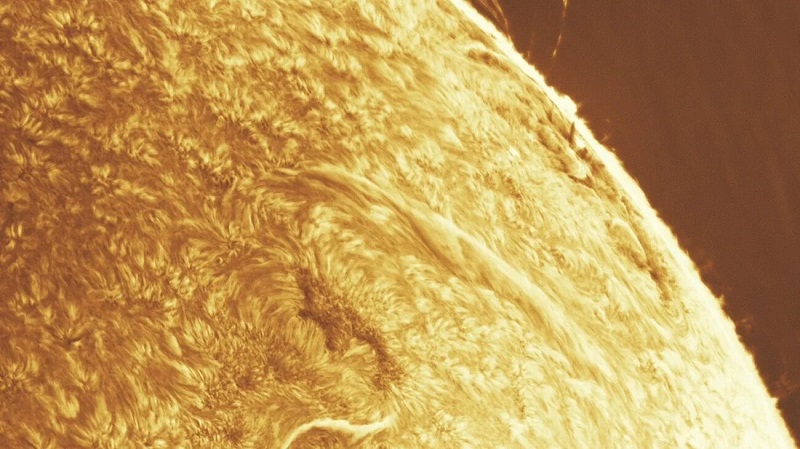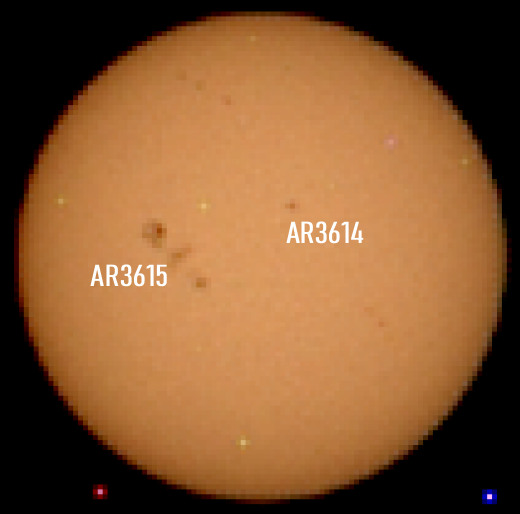SOLAR CYCLE 25 ACTIVITY REPORT MARCH 25_2024
Solar activity has been at high levels for the past 24 hours. The largest solar event of the period was a M2.2 event observed at 06:06 UTC from Region 3615 (S13W14) the flare generated a Minor R1 radio blackout over Indian Ocean
Other M-class flares generated by the same region:
● M1.3 at 07:51 UTC the flare generated a Minor R1 radio blackout over Indian Ocean
● M1.1 at 12:18 UTC the flare generated a Minor R1 radio blackout over Mid Atlantic Ocean
● M1 at 12:34 UTC the flare generated a Minor R1 radio blackout over Mid Atlantic Ocean
M1.2 at 13:14 UTC the flare generated a Minor R1 radio blackout over Mid Atlantic Ocean
Flares, CMEs and now Magnetic Filament
NOAA has updated its forecast for the next 24 hours: 99% chance of C flares, 85% chance of M flares and 25% chance of X flares.
AR3615 continues with an unstable magnetic field beta-gamma-delta. Today this active region consists of 54 cores covering an area of 810 MH.
● Auroral Activity
The geomagnetic field has been at unsettled to severe storm levels (kp6) for the past 24 hours. On March 24 Solar wind speed reached a peak of 887 km/s (High speed) at 20:35 UTC Total IMF reached 33 nT at 1607 UTC
Aurora Oval Bz: 18.86 nT North

Might this be a #solarstorm fizzle? Although this storm will continue for hours yet, whether it will contain southward magnetic field is the key for big #aurora shows. At Solar Orbiter (see the figure below), the storm has a weak "South-East-North" configuration, meaning the axis of its magnetic "solar slinky" core points mainly east with a slight tilt to the north. At Earth, early indications show this core may be oriented in a more "East-North-West" direction. If so, this does not bode well for generating aurora. With Solar Orbiter separated from Earth by 11° in longitude, it is quite possible to have a slightly "bent" ICME orientation as shown. I've seen the magnetic core of ICMEs rotate over 90° between spacecraft separated by that magnitude. STEREO-A may not give us much more insight because its longitudinal separation is over 9° from Earth. The best we can do is keep our fingers crossed that the storm still has some southward field, but sadly, it is not looking good.
Dr. Tamitha Skov

● Current Conditions at 04:35 UTC on March 25
The geomagnetic storm has weakened a little because the solar wind magnetic field turned northward. But the main body of the CME, aka, the flux rope, seems to have arrived as seen in low proton temperature. We should monitor how the magnetic field turns in the flux rope.
Halo CME vía X
Geomagnetic activity is at index Kp 4 (active) The geomagnetic storm has subsided and the solar wind, with a high speed of more than 700 km/s, is turning northward, which does not offer the best conditions for aurora sightings at high latitudes. AR3615 is taking a break after the great activity recorded on March 23 and 24. Solar activity is expected to be moderate with a chance for X-class flares in the next 24 hours. The geomagnetic field is expected to be quiet to minor storm levels on March 25
▪︎ Geospace active (Kp 4)
▪Solar wind speed record: 749 km/sec (high speed)
▪︎ density: 20 p/cm³ (moderate density)
▪︎ Interplanetary Magnetic Field (IMF)
Bt: 19 nT
▪︎ X-ray Solar Flare : C5 0104 UT Mar25
▪︎ Thermosphere Climate Index
today: Warm
▪︎ Neutron Counts today:-3.5% (Low)
▪︎ Sunspot number: 145 (SN 146 Mar 24)
▪︎ Spotless Days 2023 total: 0 days (0%)
▪︎ Earth is inside a stream of solar wind flowing from a southern coronal hole.
.......
SpaceWeatherlive.com
SpaceWeather.com
 Personally, I do not recall having reported these values for the solar wind and the Interplanetary Magnetic Field.(IMF)
Personally, I do not recall having reported these values for the solar wind and the Interplanetary Magnetic Field.(IMF)



 Personally, I do not recall having reported these values for the solar wind and the Interplanetary Magnetic Field.(IMF)
Personally, I do not recall having reported these values for the solar wind and the Interplanetary Magnetic Field.(IMF)





